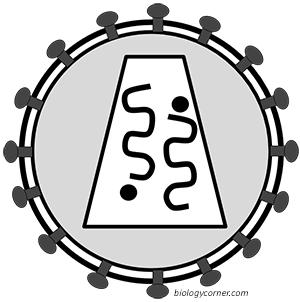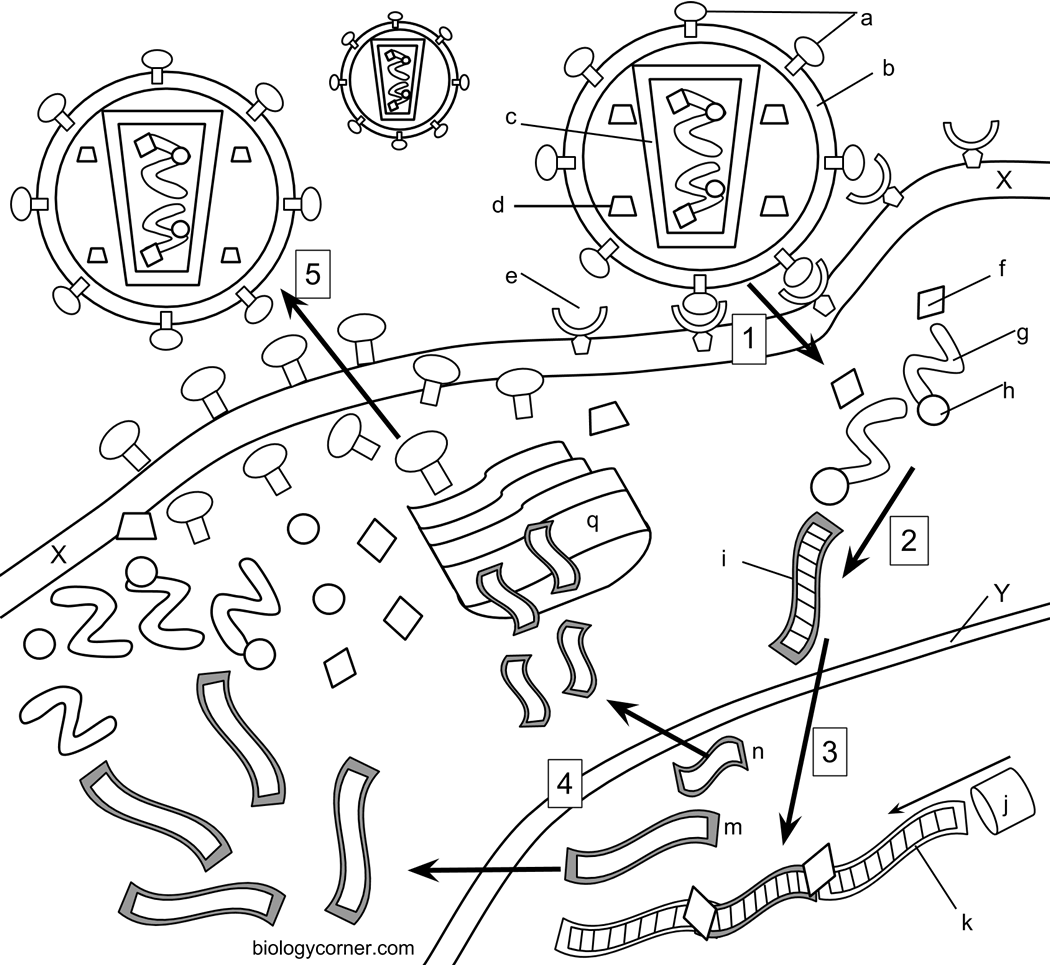How HIV Infects Cells - Coloring Activity
 In general, viruses have very small genomes which means they can encode a very limited
number of their own proteins. For this reason, most viruses must use the proteins
provided by their host in order to reproduce and make more viruses. In a way, viruses
are parasitic, they bring very little with them and steal what they need from
the host cell.
In general, viruses have very small genomes which means they can encode a very limited
number of their own proteins. For this reason, most viruses must use the proteins
provided by their host in order to reproduce and make more viruses. In a way, viruses
are parasitic, they bring very little with them and steal what they need from
the host cell.
Because they cannot reproduce on their own, viruses are not considered living organisms, they are simply genetic information, either DNA or RNA packaged within a protein coat. HIV infects a particular type of immune system cell, the T Helper Cell. Once infected, the T-Helper cell turns into an HIV replicating cell. There are typically 1 million T-cells per one milliliter of blood. HIV will slowly reduce the number of these cells until the person develops the disease AIDS.
Scientists use models to help understand how biological processes work. Models are often in the form of two dimensional diagrams that show representations of structures involved the process. The representations do not need to be physically accurate, and are often simplified images of something that might in actuality be much more complex.
The goal of the model is to guide an understanding of the process. This excercise requires you to analyze a model of how the Human Immunodefiency Virus infects a host cell. Viruses are extremely small, and our understanding of how they work is largely based on inference and what can be observed using electron microscopes. For this exercise, consider that your goal is to understand the steps in infection, while also identifying the structures that play a role in virus reproduction.
HIV Infection
The HIV (human immunodeficiency virus) has a lipid membrane similar to the cell membranes of other organisms. Color the lipid membrane (b) light green. Attached to the membrane are several envelope proteins (a) which are used to attach to the host cell. Color the envelope proteins (a) orange. Within the membrane is another layer of proteins that comprise the capsule (c), color the capsule dark green.
Step 1 - HIV enters the host by attaching to specific host receptors. It is as if the virus has a specific key that only works on the host cell with the right lock. In the case of HIV, the lock is the CD4 cell-surface antigen located on the surface of T Helper cells. Color the CD4 antigens (e) dark purple. CD4 antigens are located on the cell membranes of the cell (X) which should be colored dark blue.
At this point, the virus and the cell membrane fuse and the virion core enters the cell. The core contains the RNA and several associated proteins that are essential to viral replication. Color all instances of viral RNA (g) pink.
Step 2 - Once the viruses fuses with the cell, it unpacks its contents and leaves behind the envelope proteins on the surface of the cell.
The virus also also unpacks a protein called protease (d) which is essential for assembling the virus during the last step of the infection. Color all instances of protease brown. The third protein found in the virus is an enzyme called integrase. This enzyme will help the viral genetic material integrate into the host DNA. Color all instances of integrase (f) black.
Because the virus genome is in the form of RNA, it must first convert the RNA to DNA using an enzyme called reverse transcriptase (h). Color all instances of reverse transcriptase yellow ◯. Because the HIV virus uses the reverse transcriptase and RNA method, it is known as a retrovirus. Single stranded genetic material develops mutations more frequently than DNA viruses - this changing nature of a retrovirus makes it particularly difficult to develop vaccines for them - hence why you must get a flu shot every year but only need a polio vaccine once in your life.
The DNA is now a double stranded molecule and is ready to move into the cell's nucleas. Color the viral DNA (i) red.
Step 3 - Viral DNA, now double stranded, is transported into the nucleus (continue to color all instances of viral DNA red) and the nuclear membrane (Y) grey. In the nucleus, the enzyme called integrase ◆ fuses it with the host cell's normal DNA. Viral DNA can persist within the cell's DNA for many years in a latent state, which further complicates efforts to treat or cure the disease. Color the host cell DNA (k)light blue. It should now be obvious that the host DNA (blue) has a section of DNA that belongs to the virus (red).
Using the host's cellular enzyme, RNA polymerase, the viral DNA is transcribed back into two splices of RNA. This works like a copy machine, the cell uses the viral DNA to make thousands of copies of viral RNA. Color the RNA polymerase (j) pink.
There are two splices made in this prices: a short splice (n) which contains the instructions for making viral proteins, and a long splice (m) which is a copy of the original viral RNA. Color the short splices green and the long splices light purple in all instances.
Step 4 - The short spliced RNAs are transported to the cytoplasm where the ribosomes and golgi apparatus use the code to construct viral proteins. Color the golgi apparatus (q) light blue. The longer splices are the full length viral RNA and will become the core of new viruses. In the model, you will see many of these proteins floating around waiting to be assembled. Make sure all of these parts are colored the appropriate color.
Another enzyme, called protease (which came with the virus original) is needed to assemble the proteins into their final functional forms.
Step 5 - Using the proteins assembled from the golgi apparatus and the completed viral RNA from the long strands, the mature virus buds off from its host cell. The process of budding often destroys the host cell. Once virus infection can create millions of new viruses by hijacking the cell's DNA and cellular machinery. With most viral infections, the immune system will learn to identify infected cells and destroy them before they can make new copies of the virus.
✅ Check to make sure all of the structures are colored and review the five steps to gain a sense of the "big picture."
Questions
1. Explain the role of each of the following in HIV infection
--protease
--reverse transcriptase
--CD4 receptors
-- RNA polymerase
--integrase
- ribosomes and golgi apparatus
2. What is a retrovirus? Why is it more difficult to develop a vaccine for a retrovirus?
3. What proteins come packaged in the virus?
4. Drugs such as AZT work by inhibiting the function of reverse transcriptase. Integrase Strand Transfer Inhibitors (INSTI) are a class of antiretroviral drugs designed to block the action of integrase.
Sketch a model showing how AZT and INSTI work.
5. Another class of antiviral drugs are called protease inhibitor. Explain how this type of drug would work.
6. Viruses like smallpox and polio contain DNA instead of RNA. That means that some of the steps in the HIV model are no longer necessary. Sketch a model on the back of your coloring page that would show how a DNA virus would work. Include any proteins or structures that would still be necessary for viral infection and replications. Remember that models do not need to be physically accurate, symbols are acceptable to represent structures. It is also acceptable to use the HIV model as a template for your new design. Color isn't necessary, but it may make the model easier to understand.

Related Resources on Viruses
Slides and Notes on Viruses - Google slides and note outline, AP Biology
How Do Viruses Infect Cells - a simpler coloring activity on viruses
Unit: How Do Viruses and Bacteria Make You Sick - resources and activities
Case Study: How Do Bacteria Become Resistant - focus on MRSA

